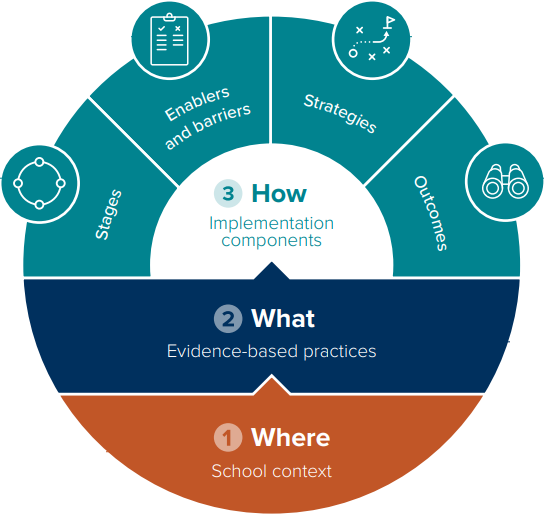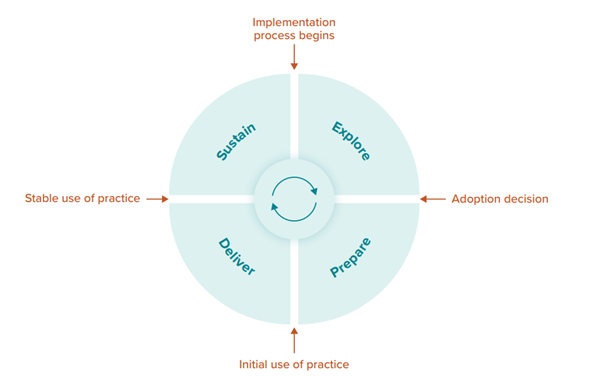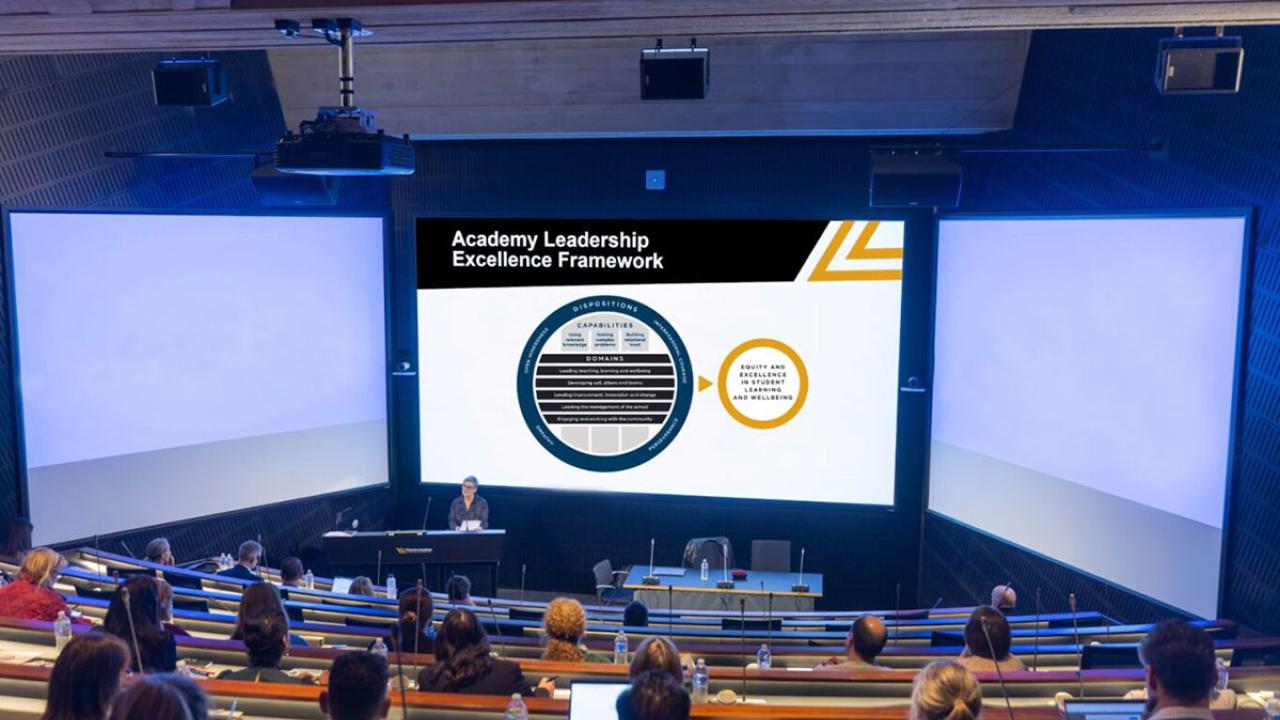12 Jun 2025
Evidence-informed implementation of changed practice in schools

The Academy has prepared a brief overview of the implementation framework and resources from the Australian Education Research Organisation (AERO). These form a collection of 5 guides or explainers. It’s best to read these in full but if you don't have time to do this immediately, this short summary will help you get started.
Guide 1: Taking an evidence-informed approach to implementation
The first guide is titled ‘Taking an evidence-informed approach to implementation’ and provides an overview of the framework for implementation. The framework consists of 3 key parts:
- The ‘Where’ stresses the need to understand the local context.
- The ‘What’, being the selection of rigorous, and relevant evidence-based practices to use in that context.
- The ‘How’ emphasises a structured, evidence-based approach to implementing new practices in classrooms and schools. It’s achieved by:
- adopting a staged approach
- addressing enablers and barriers
- developing strategies for implementation
- identifying outcomes and monitoring to ensure successful implementation.
These components establish a deliberate, structured approach to implementation and form the basis of the 4 remaining guides.

Source: AERO Explainer – Using a staged approach to implementation
Guide 2: Using a staged approach
This approach involves 4 key stages, each with specific activities and decision-making requirements. This structured approach ensures change is gradual, manageable, and adaptable to the unique needs of different context and environments. The stages below can also occur concurrently.
The explore stage involves schools to:
- identify the problem
- develop a shared understanding of the evidence-based practices that could provide solutions
- asses their suitability within the school’s context.
The prepare stage involves schools to:
- create an implementation plan
- develop strategies to support delivery of professional learning and use of evidence-based practice
- determine enablers and barriers (see section 2)
- determine implementation strategies (see section 3)
- establish data collection methods to track progress (see section 4).
The deliver stage involves schools to:
- implementing evidence-based practice in classrooms
- providing ongoing support to teachers
- monitoring implementation.
During implementation, evidence-based practices should have minimal adaptions to ensure they’re used effectively. This is known as retaining the fidelity of the practice and the degree to which an intervention or practice is implemented as intended. This doesn’t mean the practices will look the same in every classroom, but will consistently feature common elements and underpinning principles.
The sustain stage involves schools to:
- evaluate the impact of implementation and adjust as needed
- develop strategies to sustain the use of evidence-based practice over time.

Source: AERO Explainer – Using a staged approach to implementation
AERO suggests this staged approach helps schools to focus their efforts, plan effectively, and monitor their progress in implementing evidence-based practices. It also allows schools to adapt their approach as needed based on their specific context and challenges.
Guide 3: Addressing enablers and barriers
In their implementation framework, AERO also emphasise that identifying and leveraging enablers, and identifying and addressing barriers to effective implementation within a school’s context are critical.
Leveraging enablers ensure:
- Strong leadership and effective communication with stakeholders.
- Key stakeholder engagement; involving teachers, students, parents, government agencies, professional learning professionals and community members in planning and implementation.
- Balancing fidelity and flexibility to adhere to key aspects of the intervention while adjusting as necessary based on feedback within the context.
Addressing barriers ensure:
- clear expectations and accountability
- adequate resources including funding, professional learning, materials and time
- proactively developing and implementing strategies to overcome resistance to change.
With schools carefully leveraging enablers and addressing barriers that are tailored to their needs, schools can increase the likelihood of successful implementation of evidence-based practices and ultimately improve student outcomes.
Guide 4: Using key implementation strategies
AERO defines these strategies as concrete actions taken to support the adoption and sustained use of evidence-based practices. These actions may include:
- establishing clear implementation plans
- providing ongoing professional learning
- conducting regular progress monitoring
- offering individualised coaching to educators.
Every school environment is unique, with its own set of strengths, challenges, and existing structures. Therefore, schools must thoroughly assess their operating environment and align their implementation strategies to ensure successful adoption.
AERO provides a framework of implementation strategies that are grouped into 9 key areas, with corresponding examples.
For example, one domain is ‘Train and educate stakeholders’ and a corresponding implementation strategy example is to provide ongoing consultation/coaching to educators. The importance of combining and sequencing implementation strategies is emphasised.
Naming, defining and specifying strategies is suggested to help establish which strategies are appropriate and feasible in a school’s particular context and to determine which strategies to use at which stages of implementation.
Guide 5: Monitoring implementation outcomes
Monitoring outcomes is an essential, ongoing process for understanding, refining, and maximising the impact of new initiatives. There are 8 outcomes of particular importance:
- acceptability
- adoption
- appropriateness
- feasibility
- fidelity
- cost
- penetration
- sustainability.
AERO emphasises it is not realistic to closely monitor all 8 outcomes, but for schools to choose the outcomes that are most relevant for their school context. Outcomes can be monitored at different stages throughout implementation.
For example, in the early stages (explore and prepare), the feasibility, acceptability and appropriateness outcomes can be monitored. Monitoring these outcomes could use perceptions of key stakeholders and observations from professional learning sessions.
In later stages (deliver and sustain), outcomes can be used to monitor whether the evidence-based practice is being applied as intended (fidelity). Examples of data and information about fidelity could come from formative notes form learning walks, and reviews of lesson plans.
Implementation outcomes can also be monitored in relation to enablers and barriers and the particular implementation strategies selected.
Further, AERO indicate there are 4 outcomes that when monitored together increase the chance of success. These are acceptability, feasibility, fidelity and sustainability. Planning to collect data about these 4 outcomes early and focusing on these throughout the process can be the basis of a deliberate and structured approach to monitoring.
By collecting relevant data and information, schools can assess the effectiveness of practice and make informed decisions about continuing or modifying the implementation to maximise the effectiveness of enablers, while continuing to reduce or remove barriers as they arise.
Resources
The AERO guides can be found here: https://www.edresearch.edu.au/summaries-explainers/explainers/taking-evidence-informed-approach-implementation
Academy resources on a wide range of topics related to education can be found here: Resources







